UML and Project Life Cycle: Examining Independent Functionalities
VerifiedAdded on 2021/11/16
|9
|1805
|57
Report
AI Summary
This report delves into the relationship between the Unified Modeling Language (UML) and the project life cycle within the context of software development. It examines the independent nature of UML's design notation and the project management life cycle, highlighting how UML facilitates the visualization and structure of software systems, including the definition of classes and attributes, independent of a specific project life cycle. The report discusses the application of UML in different stages of software development, such as the design phase, and emphasizes the significance of selecting appropriate project management methodologies, such as Agile, to manage software development processes effectively. It also explores how UML is employed in iterative software development life cycles and how changes and consumer feedback influence the design and implementation of software. The conclusion emphasizes that while UML is a part of the design phase, a crucial stage in the project life cycle, UML's design notation is independent of the project life cycle and methodology; however, the inputs for designing UML are derived from the project life cycle stages.

Running head: UML AND PROJECT LIFE CYCLE
UML AND PROJECT LIFE CYCLE
Name of the Student:
Name o the University:
Author Note:
UML AND PROJECT LIFE CYCLE
Name of the Student:
Name o the University:
Author Note:
Paraphrase This Document
Need a fresh take? Get an instant paraphrase of this document with our AI Paraphraser
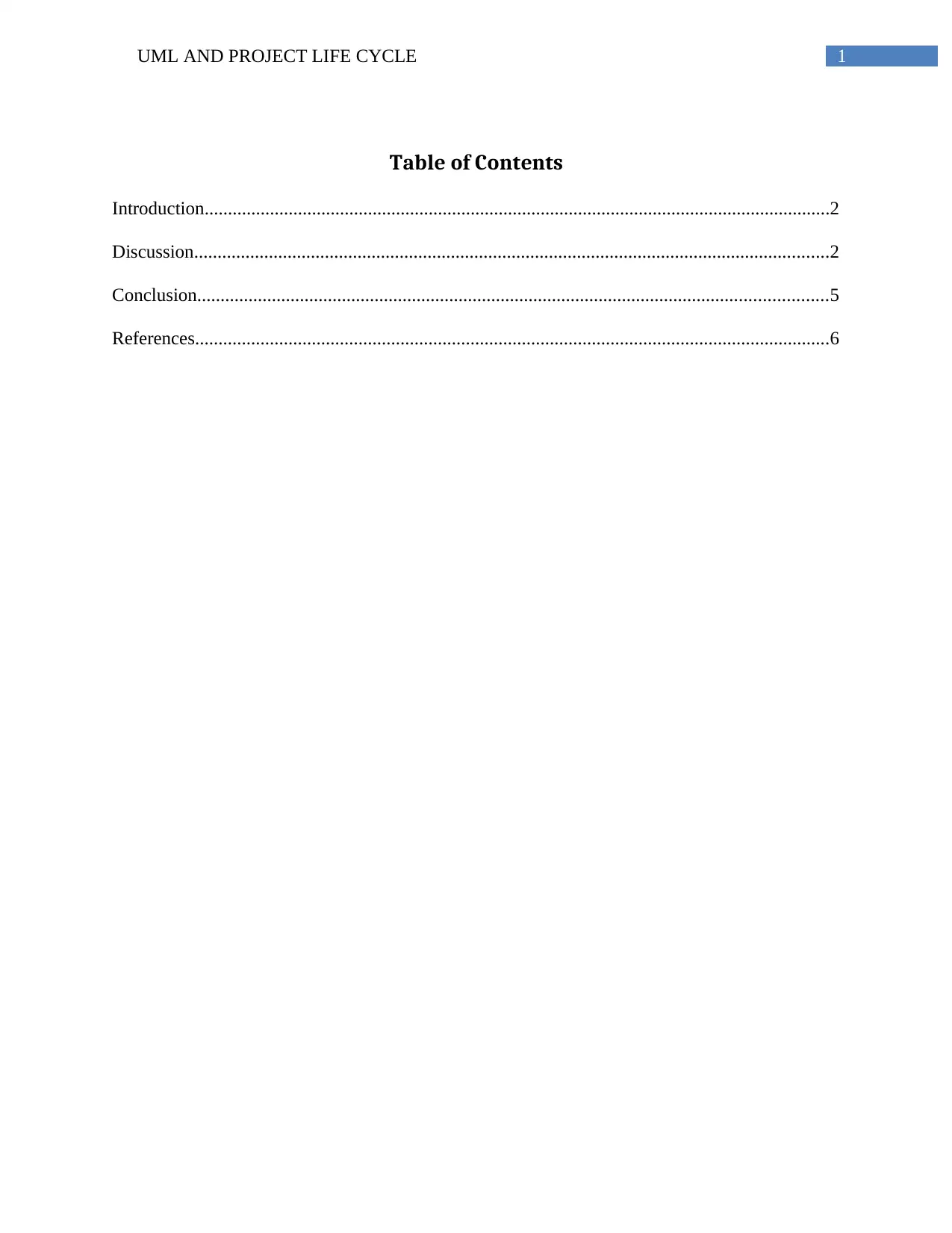
1UML AND PROJECT LIFE CYCLE
Table of Contents
Introduction......................................................................................................................................2
Discussion........................................................................................................................................2
Conclusion.......................................................................................................................................5
References........................................................................................................................................6
Table of Contents
Introduction......................................................................................................................................2
Discussion........................................................................................................................................2
Conclusion.......................................................................................................................................5
References........................................................................................................................................6
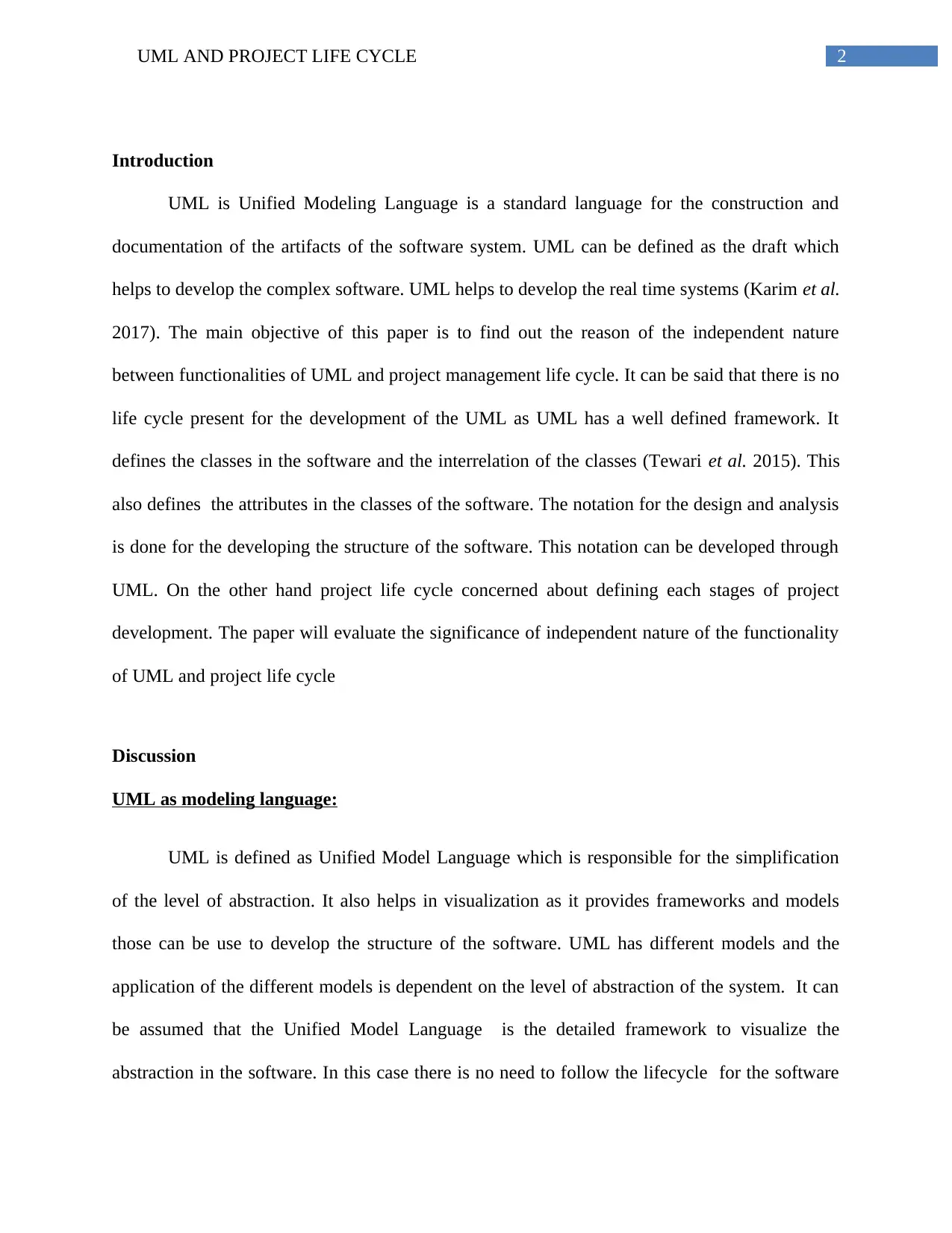
2UML AND PROJECT LIFE CYCLE
Introduction
UML is Unified Modeling Language is a standard language for the construction and
documentation of the artifacts of the software system. UML can be defined as the draft which
helps to develop the complex software. UML helps to develop the real time systems (Karim et al.
2017). The main objective of this paper is to find out the reason of the independent nature
between functionalities of UML and project management life cycle. It can be said that there is no
life cycle present for the development of the UML as UML has a well defined framework. It
defines the classes in the software and the interrelation of the classes (Tewari et al. 2015). This
also defines the attributes in the classes of the software. The notation for the design and analysis
is done for the developing the structure of the software. This notation can be developed through
UML. On the other hand project life cycle concerned about defining each stages of project
development. The paper will evaluate the significance of independent nature of the functionality
of UML and project life cycle
Discussion
UML as modeling language:
UML is defined as Unified Model Language which is responsible for the simplification
of the level of abstraction. It also helps in visualization as it provides frameworks and models
those can be use to develop the structure of the software. UML has different models and the
application of the different models is dependent on the level of abstraction of the system. It can
be assumed that the Unified Model Language is the detailed framework to visualize the
abstraction in the software. In this case there is no need to follow the lifecycle for the software
Introduction
UML is Unified Modeling Language is a standard language for the construction and
documentation of the artifacts of the software system. UML can be defined as the draft which
helps to develop the complex software. UML helps to develop the real time systems (Karim et al.
2017). The main objective of this paper is to find out the reason of the independent nature
between functionalities of UML and project management life cycle. It can be said that there is no
life cycle present for the development of the UML as UML has a well defined framework. It
defines the classes in the software and the interrelation of the classes (Tewari et al. 2015). This
also defines the attributes in the classes of the software. The notation for the design and analysis
is done for the developing the structure of the software. This notation can be developed through
UML. On the other hand project life cycle concerned about defining each stages of project
development. The paper will evaluate the significance of independent nature of the functionality
of UML and project life cycle
Discussion
UML as modeling language:
UML is defined as Unified Model Language which is responsible for the simplification
of the level of abstraction. It also helps in visualization as it provides frameworks and models
those can be use to develop the structure of the software. UML has different models and the
application of the different models is dependent on the level of abstraction of the system. It can
be assumed that the Unified Model Language is the detailed framework to visualize the
abstraction in the software. In this case there is no need to follow the lifecycle for the software
⊘ This is a preview!⊘
Do you want full access?
Subscribe today to unlock all pages.

Trusted by 1+ million students worldwide
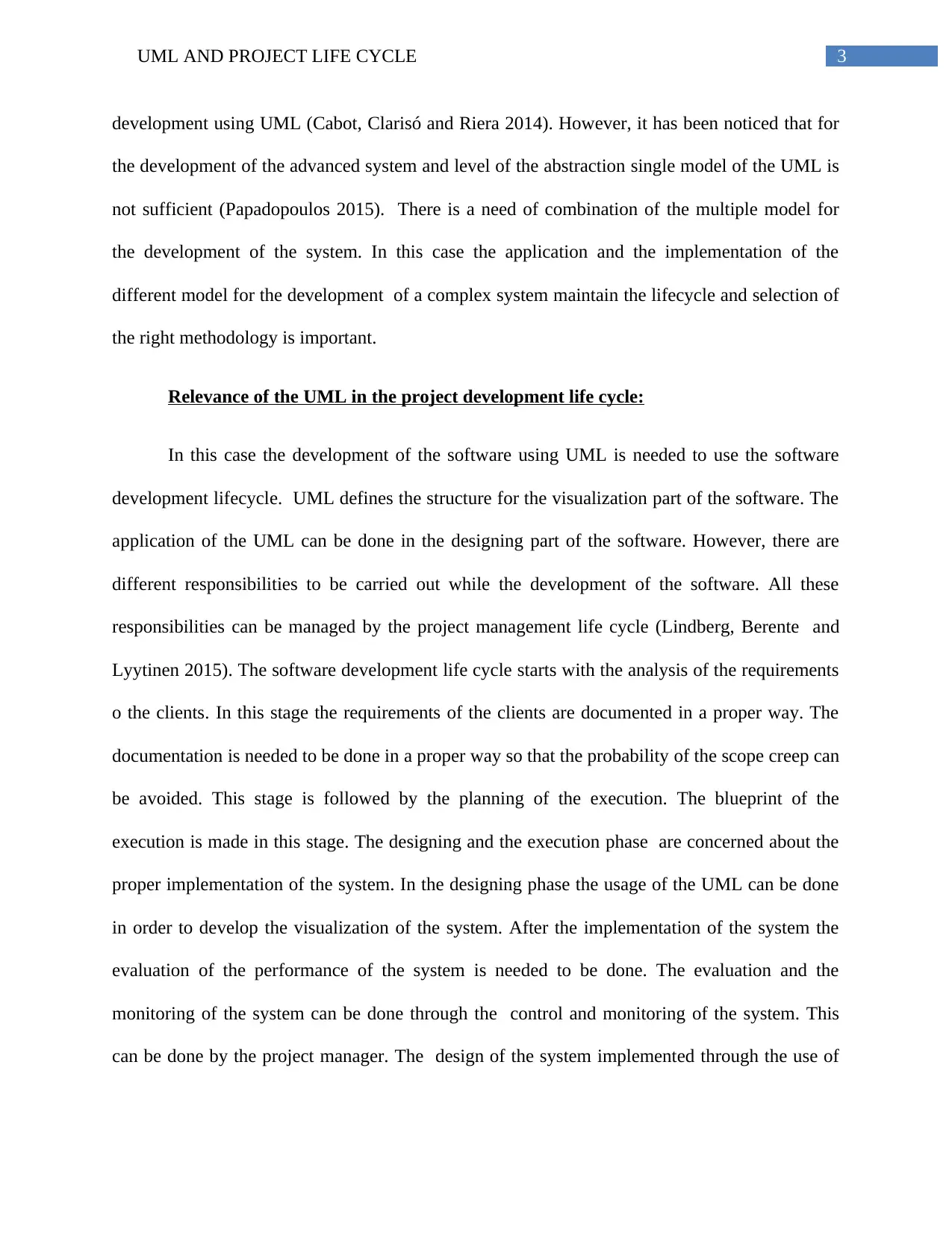
3UML AND PROJECT LIFE CYCLE
development using UML (Cabot, Clarisó and Riera 2014). However, it has been noticed that for
the development of the advanced system and level of the abstraction single model of the UML is
not sufficient (Papadopoulos 2015). There is a need of combination of the multiple model for
the development of the system. In this case the application and the implementation of the
different model for the development of a complex system maintain the lifecycle and selection of
the right methodology is important.
Relevance of the UML in the project development life cycle:
In this case the development of the software using UML is needed to use the software
development lifecycle. UML defines the structure for the visualization part of the software. The
application of the UML can be done in the designing part of the software. However, there are
different responsibilities to be carried out while the development of the software. All these
responsibilities can be managed by the project management life cycle (Lindberg, Berente and
Lyytinen 2015). The software development life cycle starts with the analysis of the requirements
o the clients. In this stage the requirements of the clients are documented in a proper way. The
documentation is needed to be done in a proper way so that the probability of the scope creep can
be avoided. This stage is followed by the planning of the execution. The blueprint of the
execution is made in this stage. The designing and the execution phase are concerned about the
proper implementation of the system. In the designing phase the usage of the UML can be done
in order to develop the visualization of the system. After the implementation of the system the
evaluation of the performance of the system is needed to be done. The evaluation and the
monitoring of the system can be done through the control and monitoring of the system. This
can be done by the project manager. The design of the system implemented through the use of
development using UML (Cabot, Clarisó and Riera 2014). However, it has been noticed that for
the development of the advanced system and level of the abstraction single model of the UML is
not sufficient (Papadopoulos 2015). There is a need of combination of the multiple model for
the development of the system. In this case the application and the implementation of the
different model for the development of a complex system maintain the lifecycle and selection of
the right methodology is important.
Relevance of the UML in the project development life cycle:
In this case the development of the software using UML is needed to use the software
development lifecycle. UML defines the structure for the visualization part of the software. The
application of the UML can be done in the designing part of the software. However, there are
different responsibilities to be carried out while the development of the software. All these
responsibilities can be managed by the project management life cycle (Lindberg, Berente and
Lyytinen 2015). The software development life cycle starts with the analysis of the requirements
o the clients. In this stage the requirements of the clients are documented in a proper way. The
documentation is needed to be done in a proper way so that the probability of the scope creep can
be avoided. This stage is followed by the planning of the execution. The blueprint of the
execution is made in this stage. The designing and the execution phase are concerned about the
proper implementation of the system. In the designing phase the usage of the UML can be done
in order to develop the visualization of the system. After the implementation of the system the
evaluation of the performance of the system is needed to be done. The evaluation and the
monitoring of the system can be done through the control and monitoring of the system. This
can be done by the project manager. The design of the system implemented through the use of
Paraphrase This Document
Need a fresh take? Get an instant paraphrase of this document with our AI Paraphraser
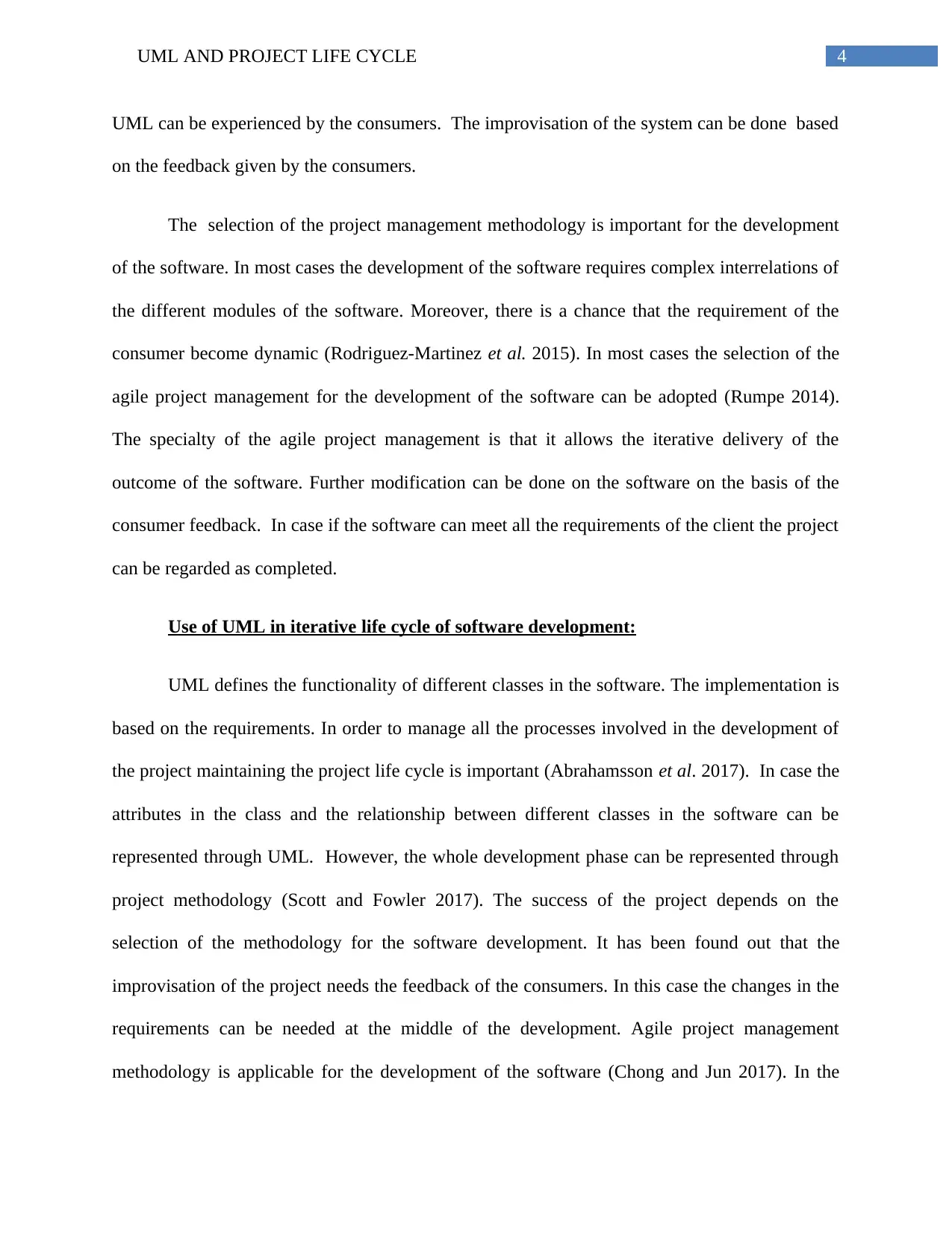
4UML AND PROJECT LIFE CYCLE
UML can be experienced by the consumers. The improvisation of the system can be done based
on the feedback given by the consumers.
The selection of the project management methodology is important for the development
of the software. In most cases the development of the software requires complex interrelations of
the different modules of the software. Moreover, there is a chance that the requirement of the
consumer become dynamic (Rodriguez-Martinez et al. 2015). In most cases the selection of the
agile project management for the development of the software can be adopted (Rumpe 2014).
The specialty of the agile project management is that it allows the iterative delivery of the
outcome of the software. Further modification can be done on the software on the basis of the
consumer feedback. In case if the software can meet all the requirements of the client the project
can be regarded as completed.
Use of UML in iterative life cycle of software development:
UML defines the functionality of different classes in the software. The implementation is
based on the requirements. In order to manage all the processes involved in the development of
the project maintaining the project life cycle is important (Abrahamsson et al. 2017). In case the
attributes in the class and the relationship between different classes in the software can be
represented through UML. However, the whole development phase can be represented through
project methodology (Scott and Fowler 2017). The success of the project depends on the
selection of the methodology for the software development. It has been found out that the
improvisation of the project needs the feedback of the consumers. In this case the changes in the
requirements can be needed at the middle of the development. Agile project management
methodology is applicable for the development of the software (Chong and Jun 2017). In the
UML can be experienced by the consumers. The improvisation of the system can be done based
on the feedback given by the consumers.
The selection of the project management methodology is important for the development
of the software. In most cases the development of the software requires complex interrelations of
the different modules of the software. Moreover, there is a chance that the requirement of the
consumer become dynamic (Rodriguez-Martinez et al. 2015). In most cases the selection of the
agile project management for the development of the software can be adopted (Rumpe 2014).
The specialty of the agile project management is that it allows the iterative delivery of the
outcome of the software. Further modification can be done on the software on the basis of the
consumer feedback. In case if the software can meet all the requirements of the client the project
can be regarded as completed.
Use of UML in iterative life cycle of software development:
UML defines the functionality of different classes in the software. The implementation is
based on the requirements. In order to manage all the processes involved in the development of
the project maintaining the project life cycle is important (Abrahamsson et al. 2017). In case the
attributes in the class and the relationship between different classes in the software can be
represented through UML. However, the whole development phase can be represented through
project methodology (Scott and Fowler 2017). The success of the project depends on the
selection of the methodology for the software development. It has been found out that the
improvisation of the project needs the feedback of the consumers. In this case the changes in the
requirements can be needed at the middle of the development. Agile project management
methodology is applicable for the development of the software (Chong and Jun 2017). In the
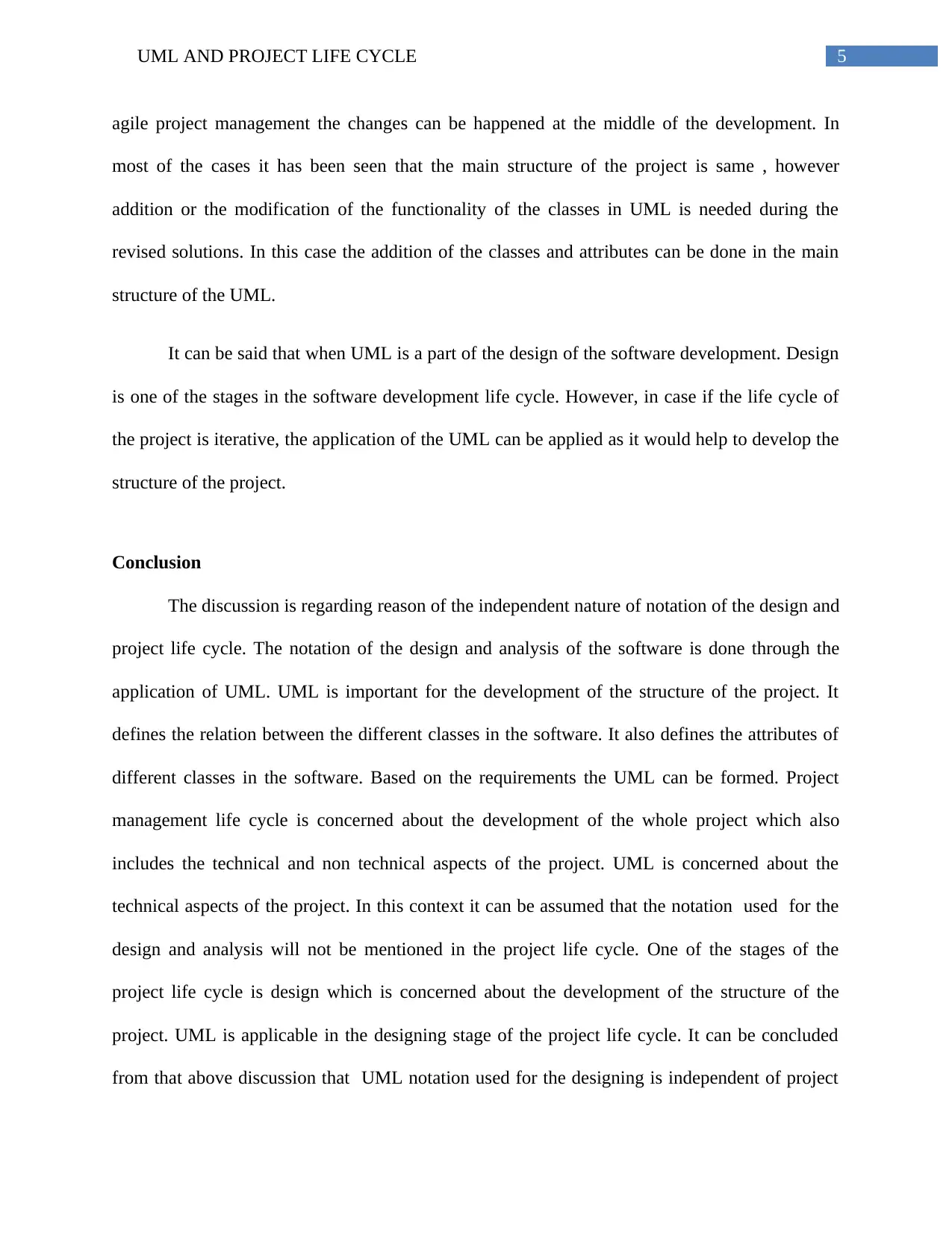
5UML AND PROJECT LIFE CYCLE
agile project management the changes can be happened at the middle of the development. In
most of the cases it has been seen that the main structure of the project is same , however
addition or the modification of the functionality of the classes in UML is needed during the
revised solutions. In this case the addition of the classes and attributes can be done in the main
structure of the UML.
It can be said that when UML is a part of the design of the software development. Design
is one of the stages in the software development life cycle. However, in case if the life cycle of
the project is iterative, the application of the UML can be applied as it would help to develop the
structure of the project.
Conclusion
The discussion is regarding reason of the independent nature of notation of the design and
project life cycle. The notation of the design and analysis of the software is done through the
application of UML. UML is important for the development of the structure of the project. It
defines the relation between the different classes in the software. It also defines the attributes of
different classes in the software. Based on the requirements the UML can be formed. Project
management life cycle is concerned about the development of the whole project which also
includes the technical and non technical aspects of the project. UML is concerned about the
technical aspects of the project. In this context it can be assumed that the notation used for the
design and analysis will not be mentioned in the project life cycle. One of the stages of the
project life cycle is design which is concerned about the development of the structure of the
project. UML is applicable in the designing stage of the project life cycle. It can be concluded
from that above discussion that UML notation used for the designing is independent of project
agile project management the changes can be happened at the middle of the development. In
most of the cases it has been seen that the main structure of the project is same , however
addition or the modification of the functionality of the classes in UML is needed during the
revised solutions. In this case the addition of the classes and attributes can be done in the main
structure of the UML.
It can be said that when UML is a part of the design of the software development. Design
is one of the stages in the software development life cycle. However, in case if the life cycle of
the project is iterative, the application of the UML can be applied as it would help to develop the
structure of the project.
Conclusion
The discussion is regarding reason of the independent nature of notation of the design and
project life cycle. The notation of the design and analysis of the software is done through the
application of UML. UML is important for the development of the structure of the project. It
defines the relation between the different classes in the software. It also defines the attributes of
different classes in the software. Based on the requirements the UML can be formed. Project
management life cycle is concerned about the development of the whole project which also
includes the technical and non technical aspects of the project. UML is concerned about the
technical aspects of the project. In this context it can be assumed that the notation used for the
design and analysis will not be mentioned in the project life cycle. One of the stages of the
project life cycle is design which is concerned about the development of the structure of the
project. UML is applicable in the designing stage of the project life cycle. It can be concluded
from that above discussion that UML notation used for the designing is independent of project
⊘ This is a preview!⊘
Do you want full access?
Subscribe today to unlock all pages.

Trusted by 1+ million students worldwide

6UML AND PROJECT LIFE CYCLE
life cycle and project methodology however, the input for designing UML is derived from one of
the stages of project life cycle.
life cycle and project methodology however, the input for designing UML is derived from one of
the stages of project life cycle.
Paraphrase This Document
Need a fresh take? Get an instant paraphrase of this document with our AI Paraphraser
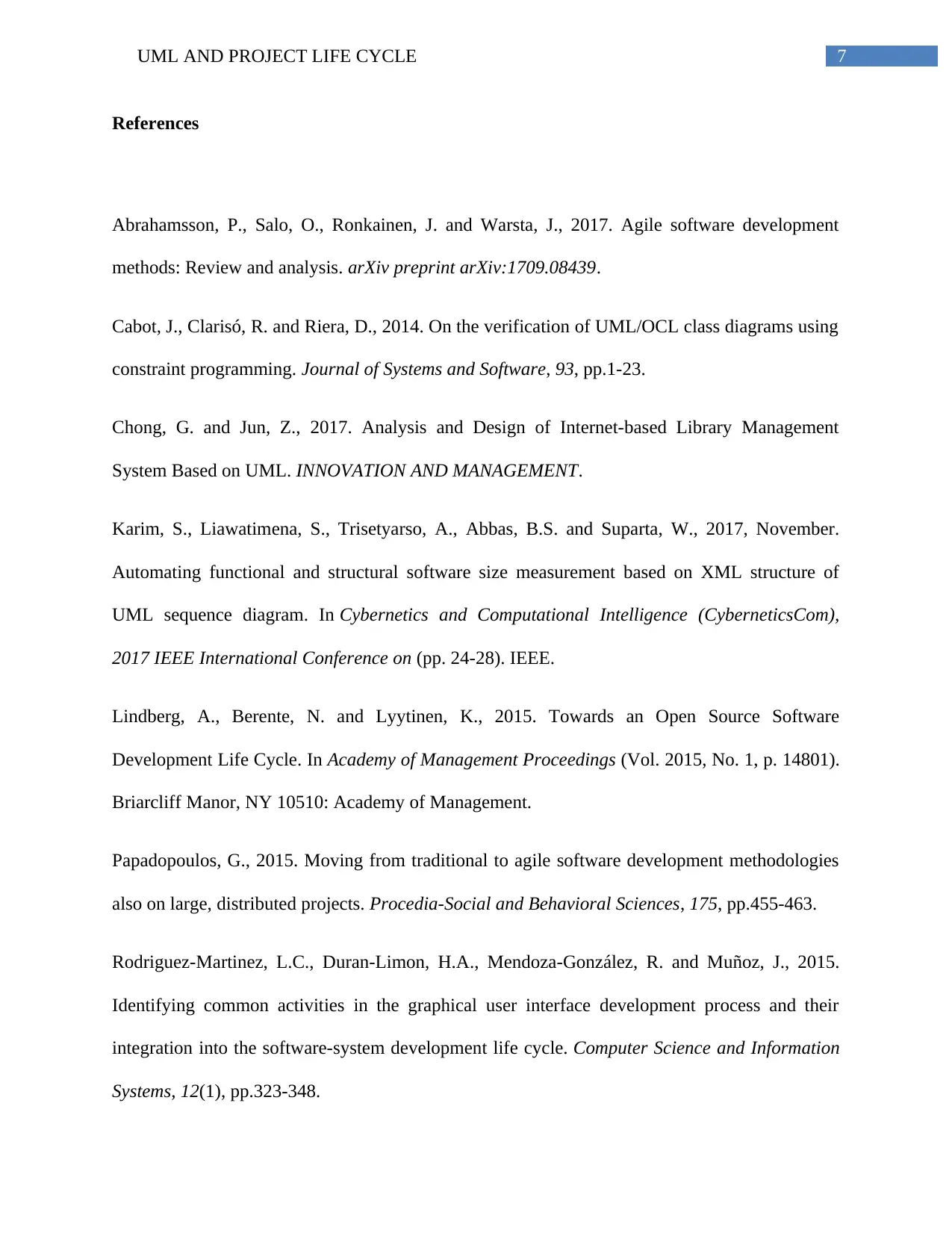
7UML AND PROJECT LIFE CYCLE
References
Abrahamsson, P., Salo, O., Ronkainen, J. and Warsta, J., 2017. Agile software development
methods: Review and analysis. arXiv preprint arXiv:1709.08439.
Cabot, J., Clarisó, R. and Riera, D., 2014. On the verification of UML/OCL class diagrams using
constraint programming. Journal of Systems and Software, 93, pp.1-23.
Chong, G. and Jun, Z., 2017. Analysis and Design of Internet-based Library Management
System Based on UML. INNOVATION AND MANAGEMENT.
Karim, S., Liawatimena, S., Trisetyarso, A., Abbas, B.S. and Suparta, W., 2017, November.
Automating functional and structural software size measurement based on XML structure of
UML sequence diagram. In Cybernetics and Computational Intelligence (CyberneticsCom),
2017 IEEE International Conference on (pp. 24-28). IEEE.
Lindberg, A., Berente, N. and Lyytinen, K., 2015. Towards an Open Source Software
Development Life Cycle. In Academy of Management Proceedings (Vol. 2015, No. 1, p. 14801).
Briarcliff Manor, NY 10510: Academy of Management.
Papadopoulos, G., 2015. Moving from traditional to agile software development methodologies
also on large, distributed projects. Procedia-Social and Behavioral Sciences, 175, pp.455-463.
Rodriguez-Martinez, L.C., Duran-Limon, H.A., Mendoza-González, R. and Muñoz, J., 2015.
Identifying common activities in the graphical user interface development process and their
integration into the software-system development life cycle. Computer Science and Information
Systems, 12(1), pp.323-348.
References
Abrahamsson, P., Salo, O., Ronkainen, J. and Warsta, J., 2017. Agile software development
methods: Review and analysis. arXiv preprint arXiv:1709.08439.
Cabot, J., Clarisó, R. and Riera, D., 2014. On the verification of UML/OCL class diagrams using
constraint programming. Journal of Systems and Software, 93, pp.1-23.
Chong, G. and Jun, Z., 2017. Analysis and Design of Internet-based Library Management
System Based on UML. INNOVATION AND MANAGEMENT.
Karim, S., Liawatimena, S., Trisetyarso, A., Abbas, B.S. and Suparta, W., 2017, November.
Automating functional and structural software size measurement based on XML structure of
UML sequence diagram. In Cybernetics and Computational Intelligence (CyberneticsCom),
2017 IEEE International Conference on (pp. 24-28). IEEE.
Lindberg, A., Berente, N. and Lyytinen, K., 2015. Towards an Open Source Software
Development Life Cycle. In Academy of Management Proceedings (Vol. 2015, No. 1, p. 14801).
Briarcliff Manor, NY 10510: Academy of Management.
Papadopoulos, G., 2015. Moving from traditional to agile software development methodologies
also on large, distributed projects. Procedia-Social and Behavioral Sciences, 175, pp.455-463.
Rodriguez-Martinez, L.C., Duran-Limon, H.A., Mendoza-González, R. and Muñoz, J., 2015.
Identifying common activities in the graphical user interface development process and their
integration into the software-system development life cycle. Computer Science and Information
Systems, 12(1), pp.323-348.
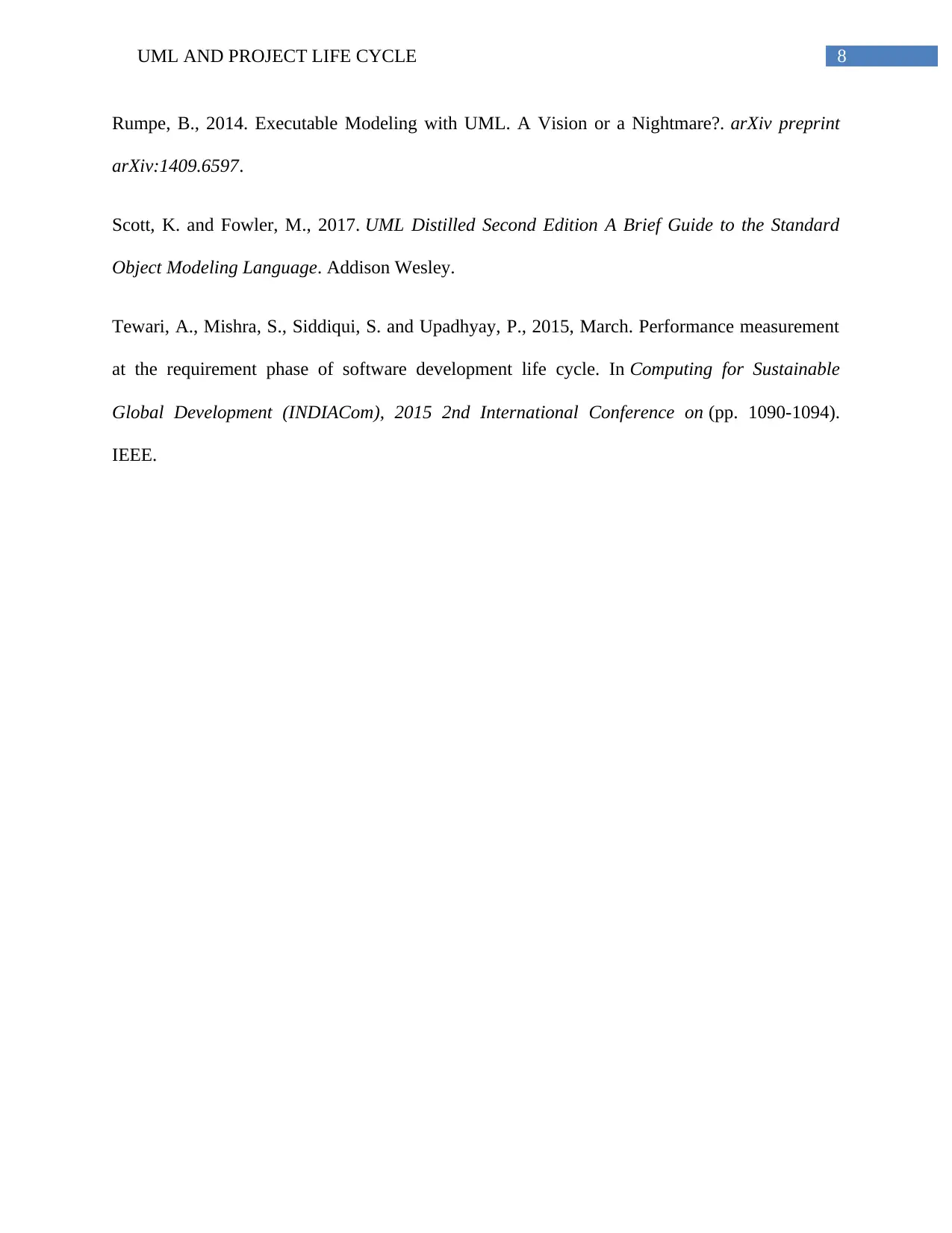
8UML AND PROJECT LIFE CYCLE
Rumpe, B., 2014. Executable Modeling with UML. A Vision or a Nightmare?. arXiv preprint
arXiv:1409.6597.
Scott, K. and Fowler, M., 2017. UML Distilled Second Edition A Brief Guide to the Standard
Object Modeling Language. Addison Wesley.
Tewari, A., Mishra, S., Siddiqui, S. and Upadhyay, P., 2015, March. Performance measurement
at the requirement phase of software development life cycle. In Computing for Sustainable
Global Development (INDIACom), 2015 2nd International Conference on (pp. 1090-1094).
IEEE.
Rumpe, B., 2014. Executable Modeling with UML. A Vision or a Nightmare?. arXiv preprint
arXiv:1409.6597.
Scott, K. and Fowler, M., 2017. UML Distilled Second Edition A Brief Guide to the Standard
Object Modeling Language. Addison Wesley.
Tewari, A., Mishra, S., Siddiqui, S. and Upadhyay, P., 2015, March. Performance measurement
at the requirement phase of software development life cycle. In Computing for Sustainable
Global Development (INDIACom), 2015 2nd International Conference on (pp. 1090-1094).
IEEE.
⊘ This is a preview!⊘
Do you want full access?
Subscribe today to unlock all pages.

Trusted by 1+ million students worldwide
1 out of 9
Related Documents
Your All-in-One AI-Powered Toolkit for Academic Success.
+13062052269
info@desklib.com
Available 24*7 on WhatsApp / Email
![[object Object]](/_next/static/media/star-bottom.7253800d.svg)
Unlock your academic potential
Copyright © 2020–2025 A2Z Services. All Rights Reserved. Developed and managed by ZUCOL.





